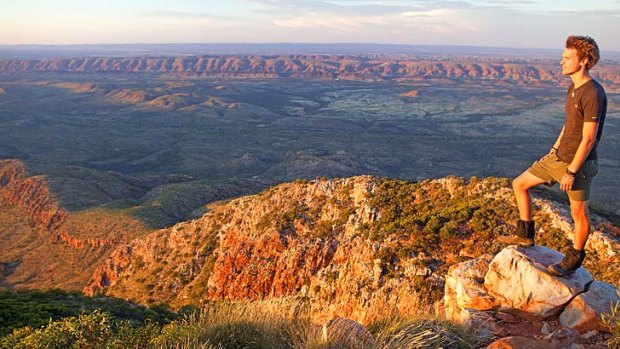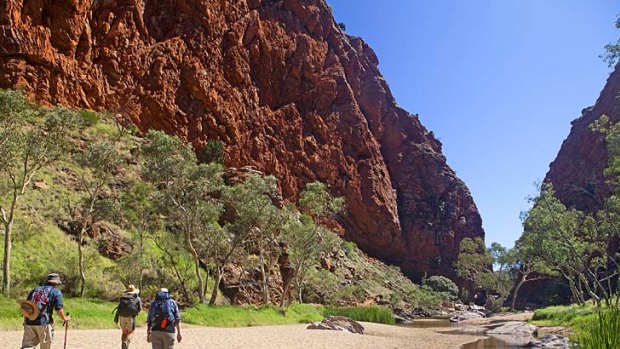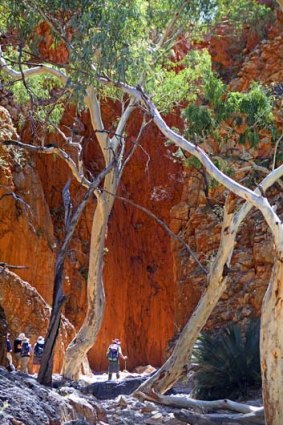Andrew Bain walks the majestic Larapinta Trail.
From the sharp crest of Euro Ridge, Alice Springs looks more like a memory than a city. I've been walking for almost three hours since leaving Alice's Telegraph Station and the city is now just a tiny part of the view, a glint of reflected sunlight amid the vast desert and mountains.
On the slopes of the ridge, the eponymous euros lie sprawled in pockets of shade, seeking cover from a belated wave of autumn heat that pushes the temperature towards 40 degrees.

High ways... a bushwalker on the summit of Mount Sonder on the Larapinta Trail.Credit: Andrew Bain
Taking their lead, we rest, sitting dotted across the slopes in the scraggly shade of the mulgas.
I've been here before, seven years ago, walking the Larapinta Trail, one of Australia's newest and finest long-distance bushwalks.
In this desert landscape, things tend to change only across millenniums, and yet so much is different to 2005.

The first day's walk at Simpsons Gap.Credit: Andrew Bain
When I first walked the Larapinta Trail, I did so independently, burying food drops in sandy creek beds and carrying my every walking need for two weeks. Today, in response to the trail's growing popularity, there are semi-permanent campsites and guided walks range from two-day samplers to two-week, end-to-end epics.
I've come this time with World Expeditions, the company that pioneered guided walks on the Larapinta. We will walk for six days, picking the eyes out of the trail highlights, though it won't all be about walking.
Some days will end with swims inside gorges or rock holes and we'll be visited in camp one night by traditional Arrernte owner Audrey McCormack, for a fireside chat. Hiking can now be just one part of the experience.

Bushwalkers at the entrance to Standley Chasm.Credit: Andrew Bain
Beginning at the Alice Springs Telegraph Station, the Larapinta Trail stretches for 223 kilometres along the length of the West MacDonnell Ranges. Conceived as an idea in 1987, track-building started two years later and was completed in 2002. It's like a West MacDonnell show reel on foot, passing through Simpsons Gap, Standley Chasm, Ellery Creek, Serpentine Gorge, Counts Point, the Ochre Pits, Ormiston Gorge, Glen Helen Resort and Mount Sonder. It's near Simpsons Gap that we're heading on the first day as we descend from Euro Ridge to Wallaby Gap, where a goanna basks on the oven-hot tin roof of a picnic shelter. Our own camp is a couple of kilometres off the trail, past statuesque ghost gums and over numerous dry, sandy creek beds. Everywhere, the land is bursting with health - it's almost a green desert - after two years of good rains.
The semi-permanent camps (which are dismantled at the end of each walking season) aren't luxury, but they are bush luxury. Tents are dotted through the buffel grass, beside a communal kitchen tent, and there are plans to upgrade next season to a larger kitchen, lounge and dining tent facing the fire pit. Composting toilets have been constructed and there is a hot bucket shower, with water heated either by sun or fire. On a day such as this one, however, nobody wants anything more than a cold shower anyway.
Over the coming days, the desert heat continues to burn, breaking briefly under cloud cover as we start the long climb to the range's main ridge out of Serpentine Gorge.
Spinifex arches over the track, stabbing at our legs, and termite mounds rise like fins between rocks. Vehicles head silently through the valley below - a world away. Across the top of the ridge the mountains have been bared by fire and it's an easy traverse to Counts Point, the Larapinta's signature lookout, with its view to distant Mount Sonder. It's atop this mountain, the most striking in the West MacDonnell Ranges, that the Larapinta Trail finishes.
From Counts Point, the trail coils down the ridge, moving through desert scrub. At its base, a tiny pool of water lingers in a creek bed.
The cloud has gone and the desert is once again on a slow boil. We strip down, dunking our shirts in water. But the best is ahead, five kilometres on, at the end of our walking day at Serpentine Chalet Dam. Built in the 1950s to supply water to a failed tourist chalet, the small concrete dam survives, tucked into the head of a rock hole, holding back waters that would otherwise have flowed away. Plates of watermelon await us, followed by a swim into a cavern where frogs cling to rock walls beside a trickling waterhole. It's the ultimate finish.
Camp this night is a short distance from the dam, cradled between spinifex-covered hills that provide vantage points to watch the rising and setting sun.
From camp, it's a short walk the next morning into Inhalanga Pass, a dry gorge almost choked with cycads, a prehistoric plant that would once have rubbed fronds with dinosaurs. South of the pass, the land is a rainbow of colours, its surface covered in yellow, orange, white and purple ochre. It's the desert in psychedelic mood. We lunch a few kilometres ahead at the Ochre Pits, a river bend with 10-metre walls of coloured mudstone and siltstone. Aboriginal people once mined these cliffs, using the pass as a trading route to the north with their ochre.
After lunch, we make the short drive to Glen Helen Gorge, where the cliffs create a passage for the Finke River, a waterway sometimes touted as the oldest in the world. We swim again in the gorge, then there's ice-cream and beer in the bar of Glen Helen Resort.
This evening, desert storms brew around us, with lightning flickering in almost every direction. We are in bed early, waking at 1am to head out to the slopes of Mount Sonder, a peak Aboriginal people called the Sleeping Woman because of its obvious feminine shape.
In the darkness, we slowly ascend, guided by torchlight. Shortly after 6am, we rise through fire-scarred slopes to the summit, beating the sun here by about half an hour. In the valley below, a bushfire burns, ignited by a lightning strike earlier in the night.
Below us, the land is mapped out in straight lines like a geometry puzzle, with mountain ranges pointing like arrows to the horizon. The view is wide, taking in Glen Helen Gorge, the meteorite crater of Gosses Bluff and Mount Zeil, the Northern Territory's highest mountain. The sun rises, turning the desert the colour of amber. We've reached the end of the Larapinta Trail, and the day has barely begun.
Andrew Bain travelled courtesy of World Expeditions and Tourism NT.
FAST FACTS
Getting there
Qantas flies from Melbourne and Sydney to Alice Springs. www.qantas.com.au
Walking there
World Expeditions has a variety of trips on a trail that is now its most popular destination. The six-day Classic Larapinta Trek (from $1690 a person) takes place on selected dates between April and the end of September. Other trips include the three-day Larapinta Experience ($995) and the 14-day Larapinta End to End ($3490). See worldexpeditions.com.au.
On the six-day Classic Larapinta Trek, long walking days are bracketed by shorter days to keep hikers fresh. The first day is the longest, about 22 kilometres, while days two and four are 10- and eight-kilometre walks respectively.
Days can top 40 degrees and nights can slide to below zero, so bring light, long-sleeve shirts for walking and a down jacket and thermals for the evenings. The heat makes thin socks (not typical woollen hiking socks) a good choice against blisters. A head torch is essential for the pre-dawn Mount Sonder ascent.
Sign up for the Traveller Deals newsletter
Get exclusive travel deals delivered straight to your inbox. Sign up now.